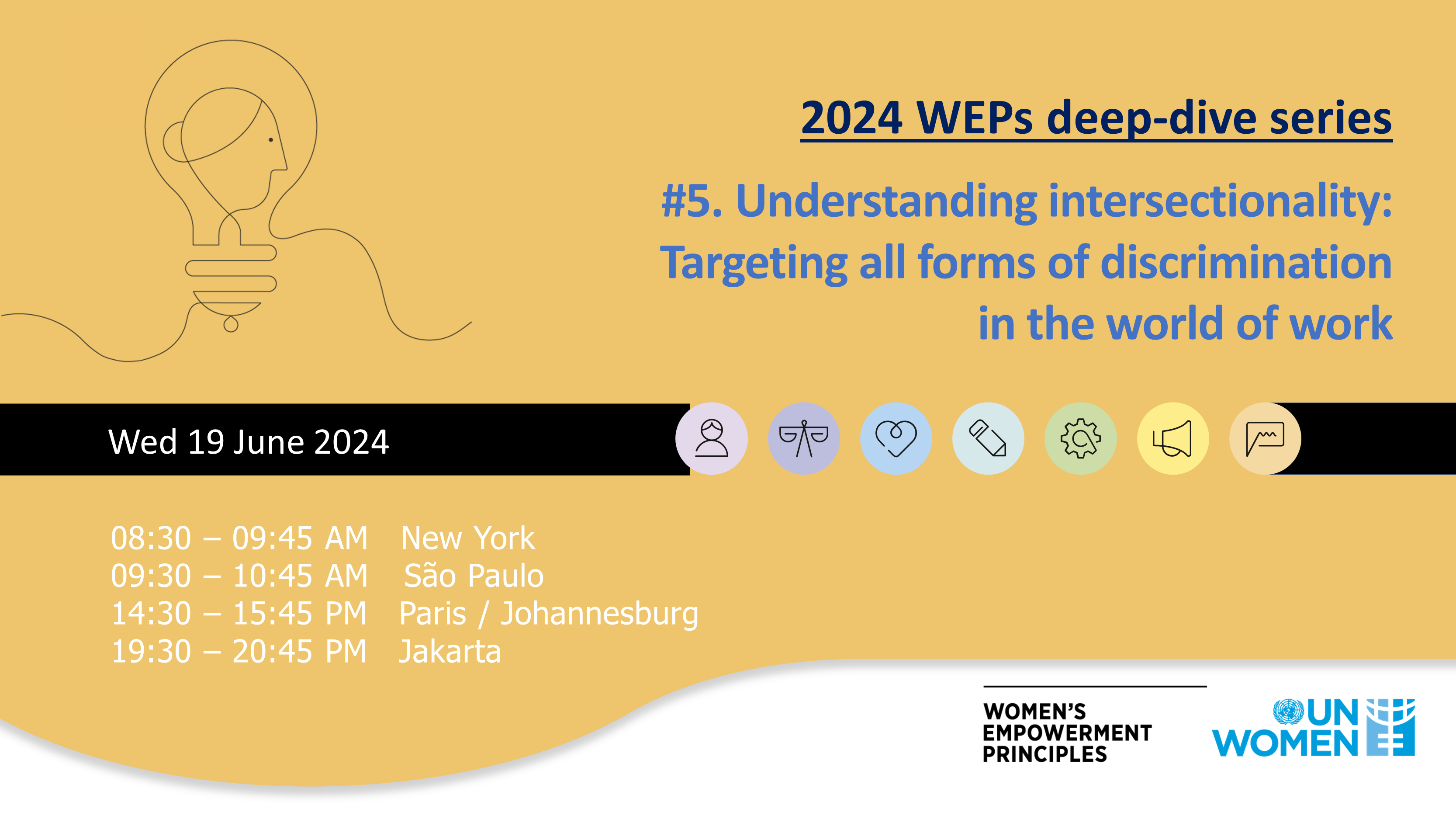Adopting an intersectional approach in business practices is not just a matter of promoting diversity; it is a strategic move that can drive innovation, enhance market competitiveness, and improve the bottom line. This was the central theme of the recent WEPs Deep-Dive Webinar on Intersectionality, where experts discussed how intersectionality influences business practices and organizational culture.
"Adopting an intersectional approach in business is crucial for fostering diversity and innovation. It helps companies better understand and meet the needs of a diverse talent, counterparts and stakeholders , enhancing market expansion and competitiveness. By considering multiple dimensions of identity, businesses can make informed decisions that positively impact their bottom line." said Anna Falth, WEPs Global Head, during her opening remarks. She also emphasized that a one-size-fits-all approach to implementing the WEPs is ineffective.
Understanding Intersectionality: Origins and Importance
“Intersectionality, a term coined by US lawyer Kimberlé Crenshaw, initially emerged from her work in examining how legal and social systems marginalize African American women”, explained Ana Claudia Jaquetto, Programme Analyst at UN Women Brazil. According to Ana, Kimberlé introduced the concept to illustrate how various social identities, such as race, gender and class, intersect and interact to create unique modes of privilege and discrimination. The concept has since been applied to describe the interplay of various social identities and socioeconomic status, and how these intersections create unique experiences of oppression or privilege.
Ana also emphasized that businesses must recognize these intersections to address the full spectrum of discrimination that individuals may face. For instance, gender-based discrimination often intersects with other forms, such as those based on sexual orientation or age, leading to compounded disadvantages. By understanding these dynamics, businesses can develop more inclusive policies that cater to the diverse needs of their employees, consumers, and other stakeholders.
The Business Case for Intersectionality
Mihwa Park, WEPs Coordinator at UN Women, showcased the tangible benefits of applying an intersectional lens to corporate’s diversity and inclusion efforts. For example, fostering a diverse and inclusive workforce can lead to higher employee satisfaction and commitment, increased innovation, and improved recruitment and retention rates. These factors, in turn, contribute to revenue growth and enhanced productivity.
However, Mihwa also noted that not all aspects of identity are visible, such as disabilities or non-binary gender identities. Thus, companies must be sensitive to both visible and invisible forms of identity to ensure comprehensive inclusivity.
Concrete Measures and Good Practices
Kalpita Ashok Dalvi, Diversity, Equity and Inclusion team member at Aditya Birla Capital (ABC) provided practical examples of how they implement intersectional strategies. These include career re-entry programmes for second career women, and the establishment of diverse employee resource groups. ABC measures the effectiveness of its intersectional approach through tools like the DEI maturity model and regular employee engagement and satisfaction surveys.
ABC's experiences illustrate that adaptability is key to successfully implementing intersectional policies. The company continuously updates its strategies based on feedback, ensuring that its practices remain relevant and effective.
Implementing an Intersectional Approach in Business
How can companies implement an intersectional approach in business? According to the speakers, the companies should adopt a holistic understanding of their stakeholders' multiple identities and experiences.
- Full Integration: Companies should connect gender equality and DEI to all its business initiatives and outcomes, and make it part of everything the company does, both internally and externally. Ongoing efforts to continuously improve and evolve make DEI more sustainable.
- Data Collection and Analysis: Companies should start by collecting comprehensive data on their employees, including demographic information that goes beyond basic gender data. This data should be analyzed within the context of broader social systems to identify patterns of inequality and inform corporate policy decisions. Qualitative data, such as employee feedback and surveys, can provide valuable insights into the lived experiences of diverse groups within the company.
- Policy Evaluation and Adaptation: Regular evaluation of policies and practices is crucial to ensure they are effective and do not unintentionally perpetuate discrimination. This includes listening to diverse voices within the organization and adjusting strategies to different cultural contexts.
- Diverse Recruitment and Retention Strategies: Companies should review and diversify their recruitment strategies to attract talent from people of all backgrounds, including those from marginalized communities. This includes implementing behavioral and competency-based interviews in hiring and promotion processes to ensure equitable opportunities for all.
- Inclusive Workplace Flexibility: Developing policies that accommodate diverse needs, such as flexible working arrangements and support for caregivers, can help create a more inclusive workplace. This not only benefits employees but also enhances overall organizational performance.
- Employee Engagement and Support: Creating employee resource groups and mentorship programmes can provide support and career development opportunities for underrepresented groups. Celebrating diversity and giving employees a voice in decision-making processes also fosters a more inclusive and engaging workplace culture.
- Transparency and Accountability: All employees need to understand the corporate commitment to gender equality and DEI. Awareness raising and accountability tools can help make gender equality and DEI a whole-of-organization endeavor.
Incorporating an intersectional lens into business practices is not merely a matter of ethics; it is a strategic imperative for companies aiming to thrive in a diverse and dynamic market. By understanding and addressing the unique experiences of their stakeholders, businesses can foster a more inclusive environment, drive innovation, and achieve sustainable growth.
Watch the recording to see the list of relevant WEPs resources.

